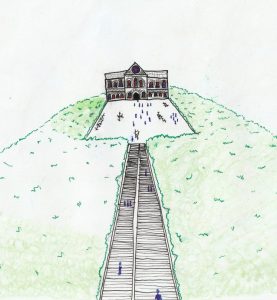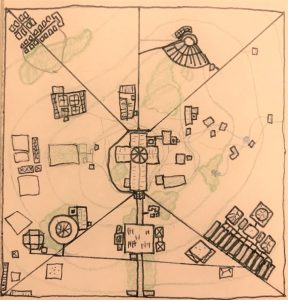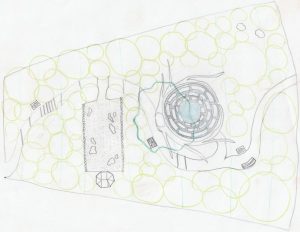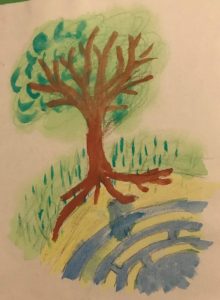
The cathedral complex was the chief architectural accomplishment of the Artens on Gear. I will go on to talk about the Geo front and the academy this housed within it in more detail in another article, but here I’m going to share my early ideas and the evolution of this location.

In the first image I depicted a simple monastic looking building, with a large square before it, at the top of the hill. I discovered this picture in my college sketchbook, so I must have been 16 or 17 when I drew it. Although my idea was vague, I knew I wanted a Cathedral on a hilltop, with a wide double stairway approach.

The second image shows my first ideas for a full complex surrounding the cathedral, it also includes my early ideas about having an Arten academy on the site. The academy is the collection of buildings in the bottom right-hand corner, there are twelve dormitories, four lecture buildings, a parade ground and a grand hall with a domed roof. Also at the bottom left-hand side are two buildings which held the Arten horse school which had its own parade ground. In the bottom left-hand corner is a circular building which would have been an observatory and a few smaller buildings around it for scientific research. At the centre of the bottom half is the pilgrim square and a few buildings to service the pilgrim’s needs and a small administration centre. The cathedral itself in the centre followed at this early stage of my thinking a Christian style building with the associated additions. Just down and to the right of the cathedral is a square building and a walled-off section of green which was the Guider’s home and garden. In the upper right corner is an open-air amphitheatre built into the hillside, the gradient of which I have roughly mapped with contour lines. In the upper left-hand corner is a series of small buildings which would have been home to the clerics of Art, and just below that are too long buildings flanking a walled garden, which was a small hospital.

This image shows an over-plan of the Guider’s garden. The walled garden is filled with ornamental trees and shrubs, giving the garden the feel of a miniature forest. There is a gravel and rock garden with a small pagoda, this private little sanctum is exclusively for the Guider. Hidden away amongst the small trees and shrubs are two Greystones, which belonged to an earlier idea. These stones were floating rocks, which I intended to be the means of levitation for an air bike, but that idea can be looked at in more detail in another article.There are three raised plinths along the edge of the path, each holding a piece of sculpture. Artens do not care much for sculpture as a rule, however they find certain natural shapes pleasing and a few individuals have experimented with artwork that we would call modernist. I’ve always imagined that the sculptures scattered around the cathedral complex and the city of Art, would look as if they had been made by Dame Barbara Hepworth. I have always loved Hepworth’s artwork, as she seems to capture in a moment natural shapes and forms in motion.

The main feature of the Guider’s garden is the great tree and the steppingstone pool. The tree’s roots wrap around the edge of the pool and its boughs lean over it. The gaps between the stepping-stones form rills with slow-moving currents of water heading for the central pool. Water and ritual bathing have always been important to Artens as they believe water is the true cleanser. The pool beneath the tree is deep enough to be fully submerged in, and on special occasions the Guider would bathe by moonlight beneath the tree, to bring he or she clarity, purity and wisdom.
